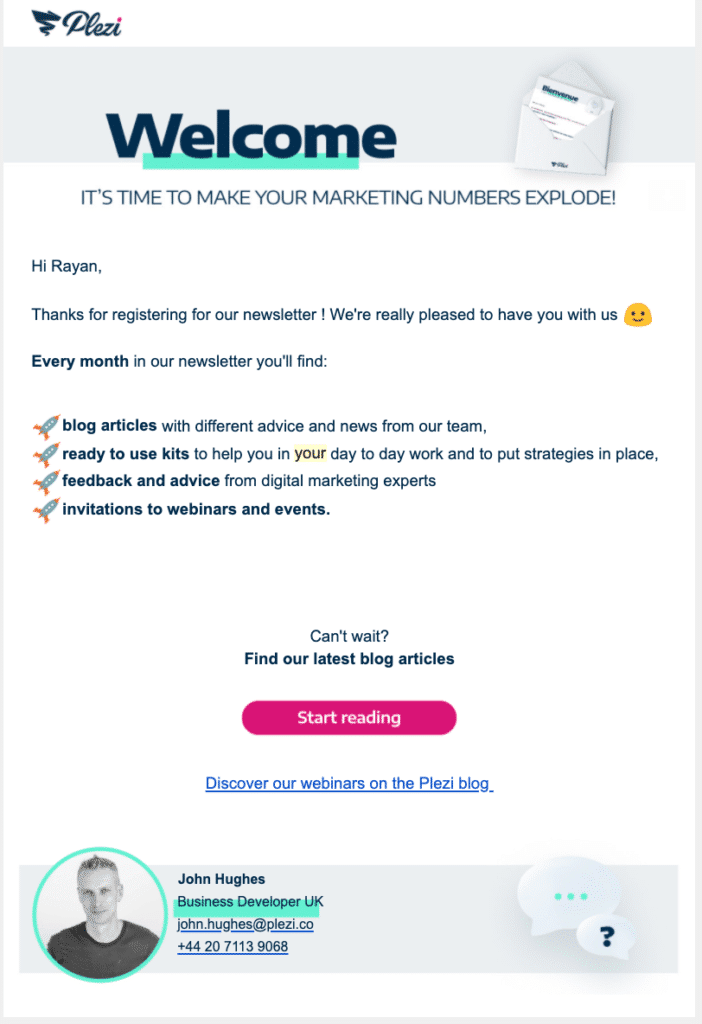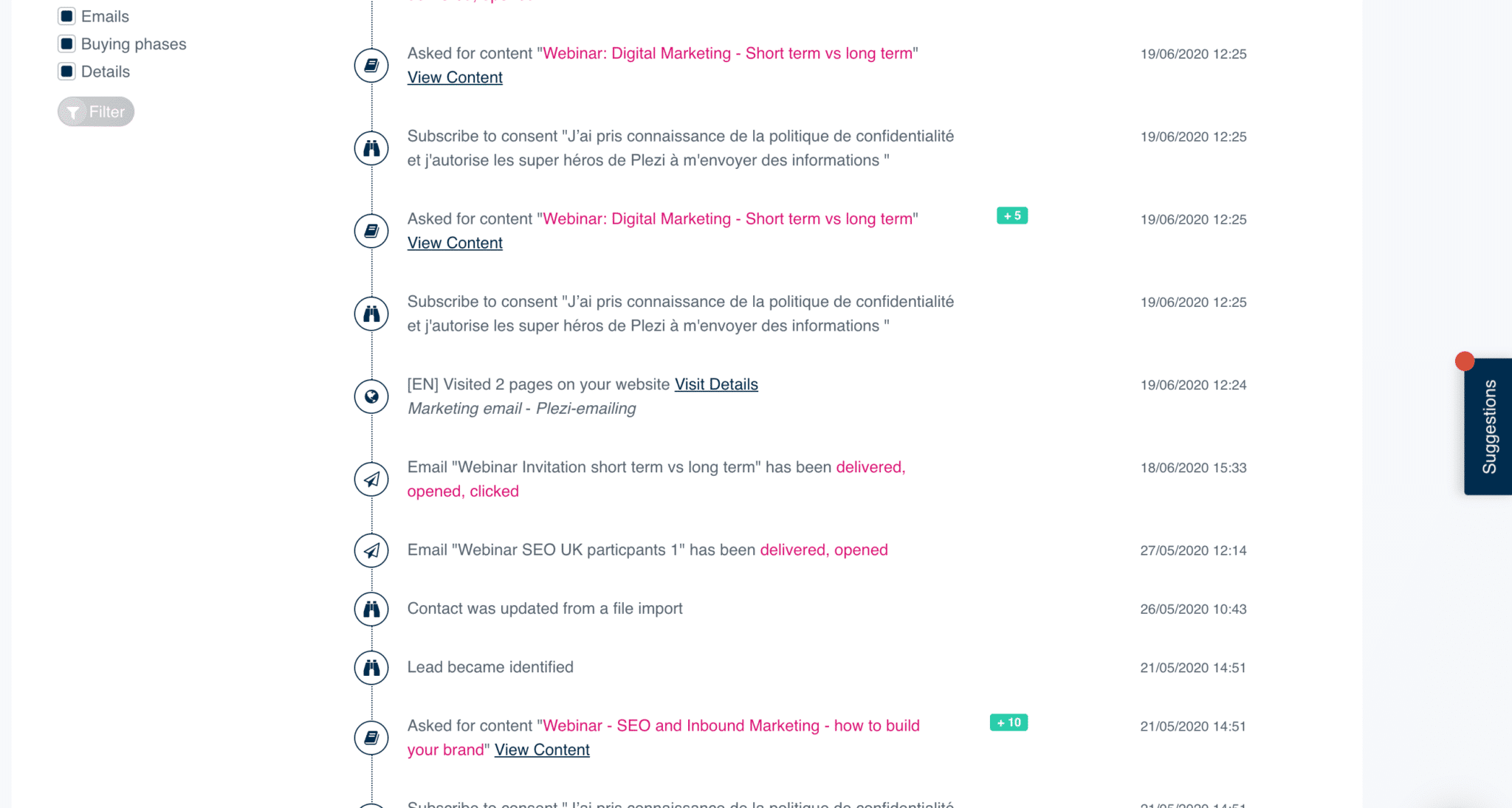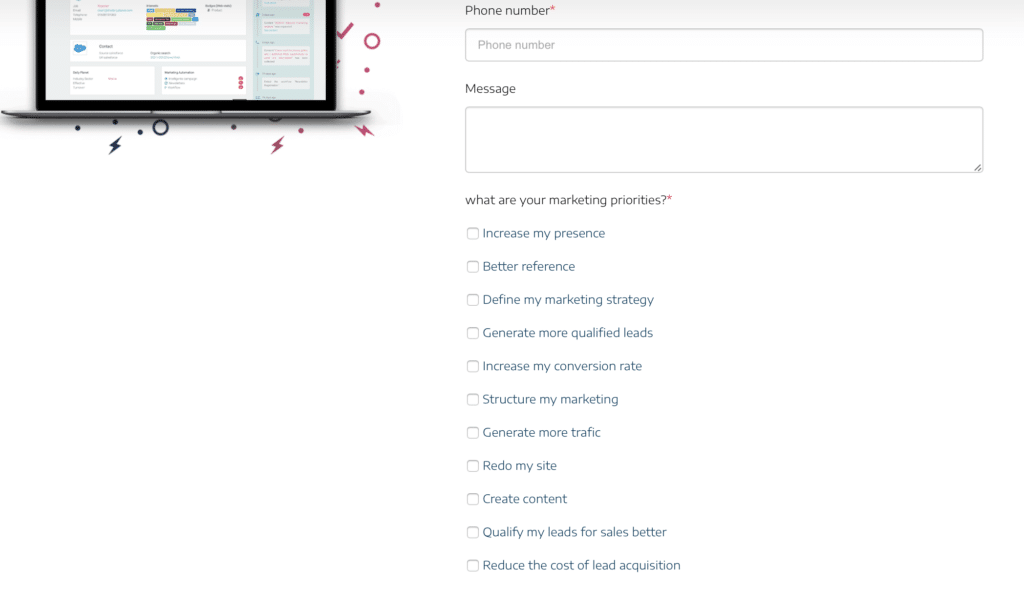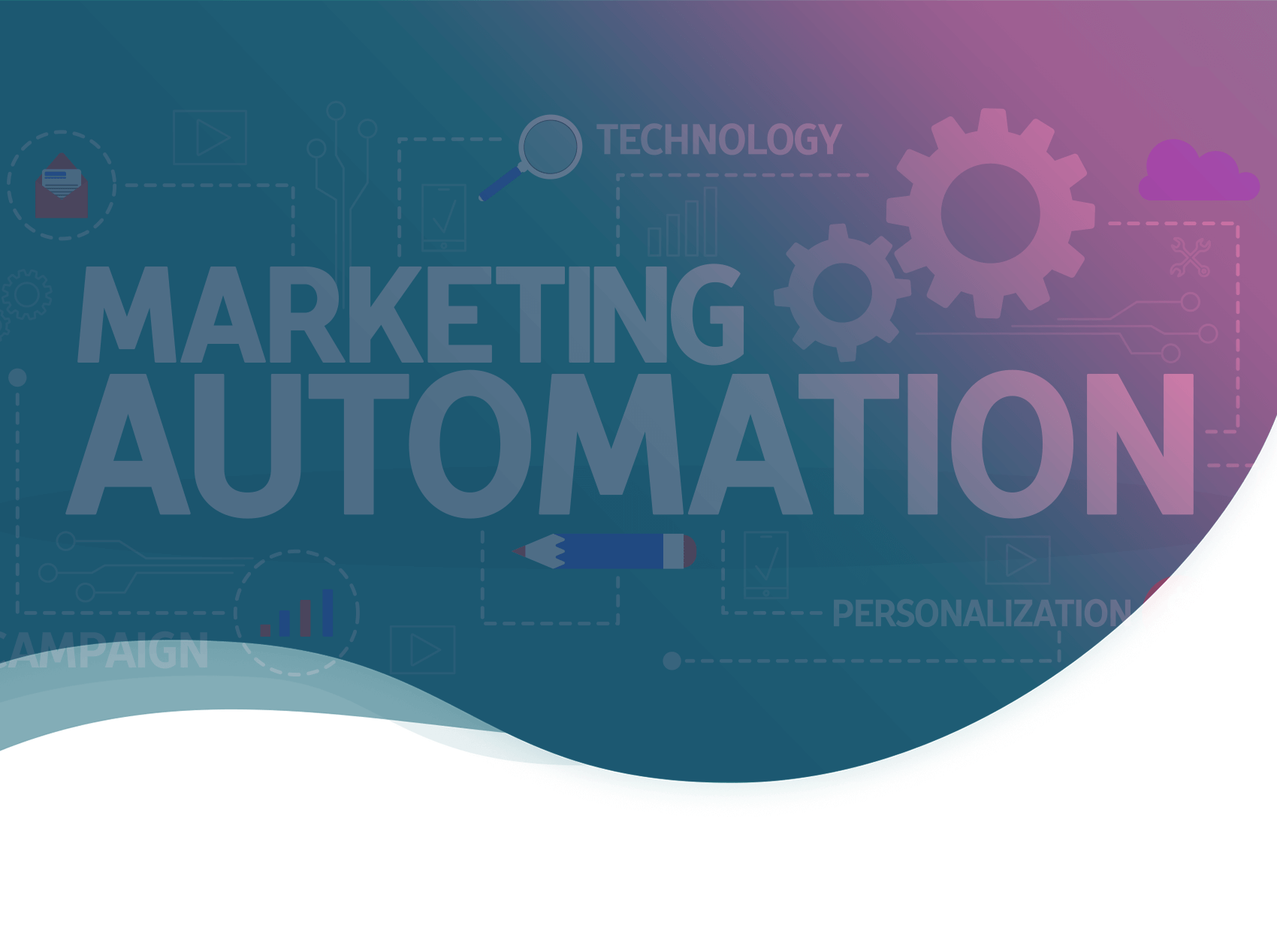The world of marketing is made up of many small, repetitive actions: writing and sending emails, checking certain figures every day, following up on prospects, qualifying them… Getting caught up in time-consuming tasks like these can easily prevent you from seeing the bigger picture and from concentrating on your long-term strategy.
This is one of the reasons why marketing automation seems to hold so much promise: it lets you entrust these repetitive tasks to a tool and to automate marketing actions in order to free up much-needed time for yourself. Automating processes doesn’t have to mean removing the human element from them, but unfortunately, that is all too often the case. Who hasn’t received a whole series of generic emails, or unwanted spam?
How, then, can you strike a good balance between the two, with a marketing automation strategy that has both a human touch and is also effective? In this article, we’ll define what marketing automation actually is, see how it works, and show how you can use it to your advantage.
 1. Definition: What is marketing automation?
1. Definition: What is marketing automation?
Marketing automation is the automating of a group of repetitive marketing actions or email marketing campaigns in order to save time.
Using marketing automation software, you can ensure that these actions are triggered by certain user behaviour and that they simulate a real conversation as naturally as possible. But marketing automation is not only useful for sending emails. It also lets you score your contacts and to automatically pass them to your sales team.
In B2B marketing, the term “marketing automation” mainly refers to the automation of email marketing campaigns whose goal is to generate and then nurture qualified prospects (leads) for salespeople throughout the buyer’s journey.
There are a number of different tools that offer this type of automation, but names can sometimes be misleading: don’t confuse marketing automation software with an email marketing tool! While the former gives you a 360° overview of your prospects’ behaviour, the latter has only a static focus on email campaigns.
2. How does marketing automation work?
If you’ve already done some research into marketing automation, it’s quite possible that you’ve read one of the many articles that link marketing automation with email scenarios (or workflows). These can certainly be useful, but in the long term, they aren’t designed for nurturing leads.
In effect, they amount to saying: “If my prospect does X, this will trigger action Y”. Although this sort of automation can work well, things quickly become much more complicated in the real world of marketing: each prospect is unique and predicting their behaviour can soon become extremely difficult if not impossible. Creating specific scenarios for the entire buyer’s journey will end up being largely a waste of time: you can’t possibly predict every eventuality and you’ll spend a huge amount of time trying to do so. And that seems a bit ridiculous for a software that’s supposed to save you time!
Our advice is to only use these scenarios for very specific situations in order to move your prospects from point A to point B. Workflows are (almost) unbeatable for doing just that!
Here are some specific examples for using workflows in your B2B marketing strategy:
#Example 1: Keeping in touch after an event
Following our presentation at a trade show in 2019, we sent out 2 emails with additional content to enable those who had attended to further explore the topic of our talk.
The aim: to keep in touch and maintain our relationship with them. The content we sent enables us to provide prospects with food for thought and to direct them to our website. There, we can learn more about them using our marketing automation software’s tracking feature.
Our scenario:
- A first article is sent to all who those attended our talk;
- 1 week later, a second piece of content (webinar) is sent if they opened the first email. If not, the first email is resent with a different email subject. If prospects open it this time, the second piece of content (webinar) is then sent to them. If not, they are removed from the scenario;
- 1 week later, if the webinar has not been downloaded, a reminder is sent with a different email subject;
- End of scenario.
Using Plezi, we can obviously adjust the timing of emails and options for the different steps.
#Example 2: Sending a welcome email
When a prospect fills out a form for the first time on our website, Plezi sends them two emails allowing us to introduce ourselves.
The aim: To welcome prospects and to start a conversation with them. Introducing our software, the team, and the content we offer is a natural way to start this conversation. This also lets us notify prospects that we will be sending them emails so as to avoid any surprise on their part.
Our scenario:
- A first email is sent based on the landing page first visited by a prospect;
- If they subscribe to our newsletter, they are sent a first thank you email with a free unique piece of content;
- If they have downloaded content from our website, they are sent a first introductory email which invites them to subscribe to our newsletter;
- If they opened the introductory email, they are sent a second email introducing Plezi one week later.
Plezi allows us to automate the sending of emails in a smart way: if prospects don’t click on emails, there’s no risk of us pestering them. Their behaviour with regards to emails is analysed and cross-referenced with their behaviour on our website, letting us adjust our strategy accordingly.
#Example 3: Lead scoring to qualify your contacts
Lead scoring is a feature that allows you to assign a given number of points to prospects according to their actions: e.g. visiting a page, opening an email, filling out a form. Allocating a certain number of points to each type of content viewed will give you a very precise idea of prospects’ progress in the marketing funnel and let you see how ready each of your prospects is to buy.
The aim: To gradually qualify contacts, and to move them from being marketing qualified leads (MQLs) to sales qualified leads (SQLs).
Our approach: Using Plezi, our marketing automation software, we allocate a certain number of points to each piece of content ahead of time. When one of our prospects views a piece of content, this number of points is added to their personal total. Because Plezi is synced to our CRM, our salespeople can see all of the content viewed by marketing qualified leads, enabling them to personalize their approach accordingly.
 View of changes to a prospect’s score in Plezi
View of changes to a prospect’s score in Plezi
3. What can marketing automation software do for you?
A marketing automation platform can do a lot more than simply automate your sending of marketing emails. Fully integrated into your work processes, it can form the foundation of your entire B2B marketing strategy.
3.1 Gives you a better understanding of your prospects
Marketing automation is THE way to learn more about your prospects.
Track their behaviour
Marketing automation software like Plezi enables you to track the behaviour of your prospects. Amongst other things, it lets you analyse:
- how they browse your website (and time spent on each page);
- how they react to your email marketing campaigns;
- content downloaded or viewed;
- their presence at your events and/or webinars.
By connecting all of these elements together, marketing automation tools enable you to organically fine-tune both the profiles of prospects and the targeting of your marketing campaigns.
Never ask them for the same information twice with progressive profiling
Some marketing automation tools let you create smart forms that gradually ask prospects for more information, meaning you no longer have to use long forms that are likely to discourage them. This progressive profiling provides you with conversion rates that are better than ever and ensures that the information you have about leads is increasingly meaningful.
3.2 Saves you valuable time
Marketing automation really delivers on what it promises, letting you focus on more strategic tasks with high added value like creating content or implementing your digital marketing strategy.
At Plezi, we’re especially fond of smart campaigns, our flagship feature, because they let us greatly amplify this effect. You no longer need to manually create workflows: a smart campaign automatically suggests certain content to our prospects in a personalized way, based on content they have viewed in the past, their interests, and profile.
A smart campaign even suggests ideas for new content that you should create.
You can also automate your social media posts to save yourself even more time and to get a clear overview of how each piece of content performs.
3.3 Lets you gradually optimize your strategies
Lead scoring, which we talked about earlier, lets you identify very quickly if a prospect is no longer moving through the marketing funnel.
By cross-checking lead scoring data with your conversion rates (visible on the dashboard of your marketing automation tool), you can optimize both your strategy and content accordingly. You can decide on the best course of action to take, whether that means fine-tuning your website landing pages, updating your white papers, webinars, blog articles, or other pieces of content.
By also monitoring lead tracking results, the behaviour of visitors, and the numbers of both views and downloads of content, you can adjust your marketing content strategy to ensure you deliver value to prospects over the long term.
To improve the effectiveness of emails, you can also analyse open rates, click rates, and churn rates.
3.4 Makes your sales team more effective
If your sales team is unfamiliar with inbound marketing and marketing automation, don’t worry, soon they won’t be able to do without them. Marketing automation lets you identify when to send the hottest leads to salespeople to optimize their conversion.
The job of your sales team is made easier by the information collected during prospects’ visits to your website, which outlines not only their interests, but also their budget and roles.
Marketing automation also shortens your sales cycle: if you’ve put in place a strategy for lead scoring, all leads that reach a pre-defined score go straight into your CRM. That way, none of them can fall through the net!
Last but not least, marketing automation can help salespeople deal with cold calling leads: by moving cold leads into a smart campaign’s nurturing cycle, salespeople give themselves the best possible chance when they make the next call.
4. Who can marketing automation benefit?
Regardless of your stage of development, marketing automation can play a key role in helping you achieve your objectives.
By providing you with a comprehensive overview of the results of your marketing campaigns, you can use it to develop a real lead generating machine and to optimize your existing processes.
But it’s not just something to be used by companies with a highly developed marketing team and well-defined strategies. On the contrary, the best way to develop a successful marketing strategy is by starting small and making gradual improvements to it.
And if you’re already generating leads, introducing a marketing automation tool can also let you send hot leads to salespeople quickly. This is a simple way to both shorten your sales cycle and to create a more effective relationship with the sales team.
The time it takes to implement an inbound marketing strategy and to see a return on investment from it may seem longer when compared with other methods. But coupled with a marketing automation tool, it can enable you to quickly generate both direct and indirect results.
Marketing automation is more than just a buzzword. It not only allows you to automate repetitive tasks, it can also save you valuable time every day. This lets you focus on the tasks that really matter so you can continually improve your marketing strategy.





